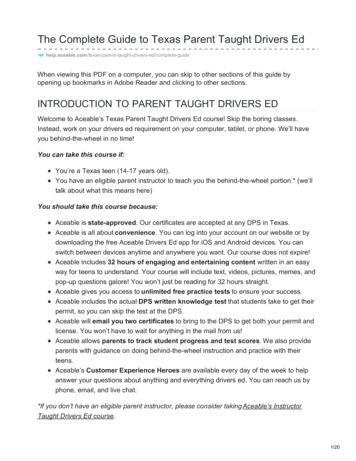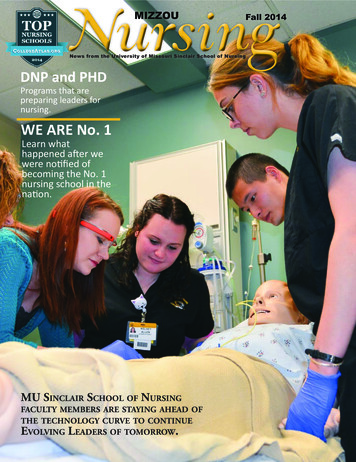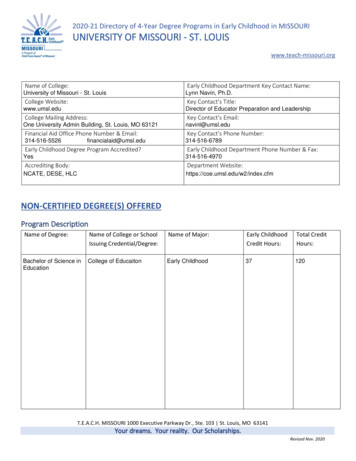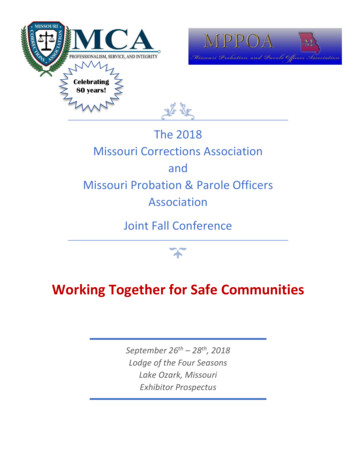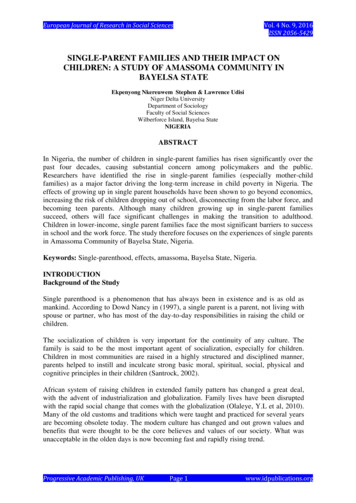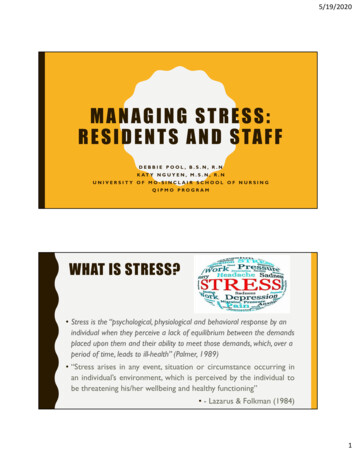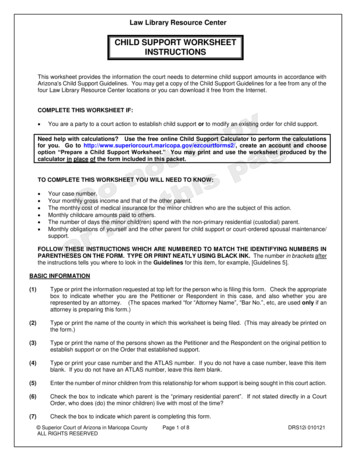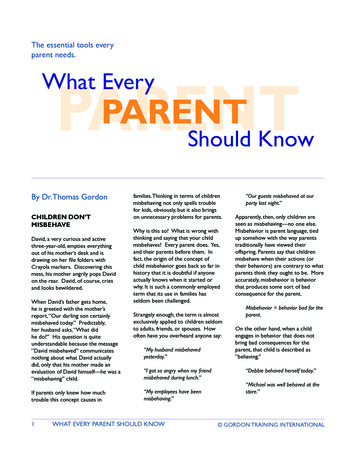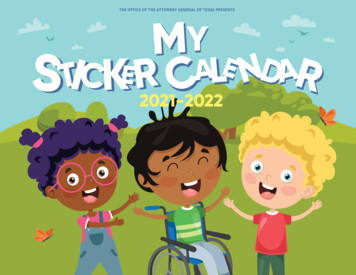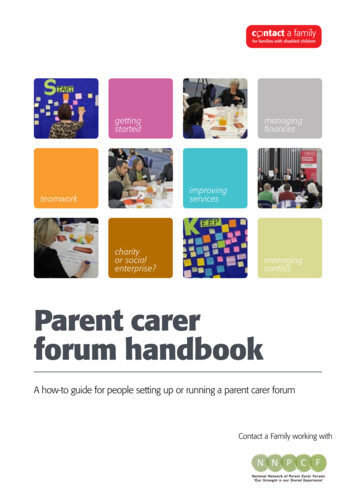
Transcription
Resource ParentHandbook1
Table of ContentsIntroduction . 03Frequently Asked Questions . 04Your Maintenance Payments . 06Rights & Responsibilities . 07Your Consenting Rights . 08MO HealthNet & Managed Care. 09Initial Placement . 10 Questions to ask upon placement . 11Adverse Childhood Experiences (ACEs) . 12Attachment and Trauma . 13 Attachment . 14 Trauma . 15Behavioral Management . 16 Tackling Transitions . 17Rules & Expectations . 18Caring for Infants & Toddlers . 21Child Care Services . 22Respite Care . 23Family Visitation . 24Education . 25Family Support Team Process . 26 Permanency Planning . 27 Concurrent Planning . 28Court Information . 29 Hearing Types & Time Frames . 30Continual Training . 31Resource Parent Support . 32Mental Health & Disability Resources . 33Signature Page . 372
IntroductionAs a resource parent, you have successfully completed your training and licensing and are considered a vitalmember of the Family Support Division Team. Your license means you can offer 24-hour care to fosterchildren and, ultimately, change their lives for the better. Your license is valid for 2 years and is nottransferable (meaning it only applies to the person it was issued to). Please keep your license in your home.Taking in foster children is a huge responsibility and requires staying organized for the various court hearings,team meetings, appointments, and visitations the child will rely on you to help with. However, your mostimportant job is giving them the unconditional love and support they might not have experienced from anadult or care giver before.In this handbook, we discuss the two teams you will be a part of — the Family Support Team (FST) and thePermanency Planning Review Team (PPRT). Although their time scales, goals, and obligations are separate,both teams meet regularly to make recommendations for children placed in your home. This handbook willalso tell you what to expect once you bring a child into your care, how to handle court, and the variousresources available to you as a foster parent.We are excited to have you on our team to help support the lives and wellbeing of children in need. As avaluable member of your foster child’s support team, don’t hesitate to reach out to your Children’s ServiceWorker with questions or concerns.3
Frequently Asked QuestionsHow does visitation work?Our goal is for children to visit siblings and family members at least once a week to help maintain thoserelationships. Visitation might be supervised, if needed, and should be at a location that is convenient andcomfortable for all involved.What permissions can I give my foster child(ren)?Although your foster children will legally be in state custody, as resource parents, you will have control overmost of the day-to-day activities and appointments for the child. See page 8 for more information on whatyou can consent to as a foster parent.How am I involved in the child’s education?As the child’s primary care giver, you will be involved in their education including where they go to school,what extra-curricular activities they’re a part of, and helping them with homework and projects.Can a foster child join us on our family vacations and trips?Your foster children can join you on vacations with approval from the court and the child’s case worker;however, risks include how medical coverage is handled outside the state. See page 16, for more travelinformation.What is appropriate discipline?Corporal punishment against foster children is strictly prohibited, as is verbal abuse or personal derogatoryremarks. Discipline should be used in a fair, constructive, and consistent manner.4
Frequently Asked Questions ContinuedWho consents to routine and emergency medical care?You will have the authority to consent to many of the child’s basic medical needs, including regular check-upsand routine appointments; however, there are many exceptions to this general rule. For more information onwhat you can consent to as a resource parent, see page 8. For more information on your foster child’smedical coverage, see pages 9 and 10.How do I receive mileage reimbursements and clothing vouchers?Part of your monthly maintenance payment is intended to cover such costs. Children will also receive a yearlyclothing allowance. Transportation costs will be paid at the current state mileage as of the date of the trip.For more information on reimbursement and vouchers, find page 6 of this handbook.If I work, can a foster child be in child care?You may ask for child-care services if there is a valid need. Child care is also available if it is in support of achild’s case plan and/or written service agreement. Our staff must authorize child care to a DSS-compliant, childcare provider. Child care must be authorized for one full year. Both the resource parent and child careprovider will receive an Authorization Notice when the child has been authorized for child care. For moreinformation on child care service, please see page 22.Are there any local support groups for resource parents?There are several statewide newsletters for resource families of Missouri depending on where you live.Contact your local Foster Care Association Board for more information about these. There are also groupsand organizations you might be interested in joining listed on page 32 of this handbook.How do I receive my maintenance payment?We recommend direct deposit to avoid delays in receiving payments. The form, CD-122, is located atChildren’s Division E-Forms dssweb/cs/forms/. Search for CD-122 in the search bar to find the application inSpanish or in English.What if my foster child damages my home or property?In such instances, notify the child’s case manager immediately, so you can discuss how to proceed, includingfiling an incident report with local law enforcement. Also, check with your insurance agent on homeowner’scoverage. For more information on emergency information and behavioral management, turn to pages 16-17of this handbook.Are there any tax breaks for resource parents?Resource parents may be eligible for tax benefits worth, in some cases, several-thousand dollars. Certain taxbenefits help low-income families, while some can aid middle- and even high-income families. Resourcefamilies should meet with a tax advisor or the IRS to discuss which tax benefits apply to them.5
Your Maintenance PaymentsWe understand payment is important for you to care for your family, including your foster children. Themaintenance reimbursement is a monthly payment to offset the cost of room and board, incidentals, andclothing for the child. If a child is not in your home for the entire month, payments are prorated for thenumber of nights the child spent in your home.You can find the current standard reimbursement rate in the Child Welfare Manual at tinyurl.com/MaintenanceFigures (Section 4, Chapter 12.8). Direct deposit is available to avoid delays in receivingpayments. The form, CD-122, is located at Children’s Division E-Forms dss.mo.gov/cd/info/forms/.Infant AllowanceIn qualifying placement types, a child between 0-36 months old is eligible for an additional 50 per month tohelp meet infant-specific needs, such as diapers, formula, clothing, and supplies.Clothing AllowancePart of your monthly maintenance payment is intended to cover such costs. Children will also receive a yearlyclothing allowance. To use this allowance, call the child’s case manager to see how much money is availableto the child. Beginning July 1, 2021, foster children are eligible for the following clothing allowance rates:0-5 Years6-12 Years13 Years 320 400 700Mileage ReimbursementYou can apply for mileage reimbursement for transportation costs as outlined in the Child Welfare Manual,Section 4 Chapter 12 subsection 8. The Travel Expense Log, CD-106, must be completed and submitted tothe Children’s Division within 30 days of the month the trip occurred. You can find the Travel Expense Log atdssweb/cs/forms/ and searching “CD-106” in the search bar. Transportation costs will be paid at the currentstate mileage as of the date of the trip.For more information on reimbursement, visit nderpayment of Maintenance CostsIf at any time you receive the incorrect amount of money, it is important you notify your local Children’sDivision office immediately, so we can correct the payment. If you are paid too much, we must recover theextra from you. Please review your check each month for accuracy, as we realize an unexpected reductionin your check could cause a hardship.6
Foster Parent Rights & Responsibilities1. Foster parents are colleagues in the child-welfare team and are to be treated as such. Likewise, fosterparents shall treat the children in their care, the child's birth family, and members of the child welfareteam in a manner consistent with their ethical responsibilities as professional team members.2. You shall be provided with regularly scheduled opportunities for pre-service training and opportunitiesfor pertinent in-service training, as determined by the Missouri State Foster Care and Adoption AdvisoryBoard and all pertinent information regarding your foster child.3. The Children’s Division shall arrange preplacement visits, except in emergencies. Furthermore, the fosterparents may ask questions about the child's case plan, encourage a placement, or refuse a placementwithout reprisal from the case worker or agency. After a placement, the Children’s Division and itscontractors shall update the foster parents as new information about the child is gathered.4. You will be informed of and able to participate in all team meetings and staffing concerning yourlicensure status or of children placed in your home.5. You will have accessible respite care for children in foster care for short periods of time, jointlydetermined by foster parents and the child's caseworker.6. All information provided to you about your foster child’s case is confidential, unless necessary for thechild’s health care, schooling, or welfare team.7. You will make decisions about the daily living concerns of the child8. You are permitted to continue the practice of your family values and routines while respecting the child'scultural heritage, cultural identity, and needs. You will receive cultural training, including information onskin and hair care, religious or cultural practices of the child’s biological family, and referrals tocommunity resources for ongoing education and support.9. Corporal punishment is not permitted. The purpose of discipline is to teach and direct the behavior of thechild and ensure it is administered in a humane and sensitive manner.10. Except in emergencies, you are given two weeks notice and a written statement of the reasons before achild is removed from your care. When requesting removal of a child from your home, you must also givetwo weeks notice to the child’s case worker, except in emergency situations.11. If requested, you will receive information about the child’s progress after they leave foster care.12. If a child re-enters the foster care system and is not placed in a relative home, the child's former fosterparents will be given first consideration for placement of the child.13. If a child becomes free for adoption while in foster care, the child's foster family will be given preferentialconsideration as adoptive parents.7
Your Consenting RightsSign all forms with “Your name, resource parent for CD.”Do not sign any forms promising to pay any bills or pay for any medical care, as CDcannot guarantee reimbursement to you.As a resource parent, you may consent to: Public school registration Initial evaluation and placement for special education and related services Making/changing class schedule Absence from school Participation in extracurricular activities School meal programs Routine medical/dental checkups Short-term inter-county travel Application for worker’s permit and releases Initiate screening test for developmental disabilities Mental health assessmentsYou must discuss the following with the child’s worker before proceeding: Release of school or mental health records to a third party Psychiatric/psychological evaluation or outpatient treatment Photographs taken for publicity purposes or media promotions Emergency routine surgery or major medical testing/procedures Enlistment in armed forces or Job Corps Marriage Registration in special schools Application for driver’s training permit and license Interstate/international travel Examination by law enforcement or Religious ceremonies (baptism, confirmation, etc.)Some of the above will require birth parent approval, Family Support Team approval, or a court order. Ifyou have questions, please contact your worker.You will also be required to complete the following training on Reasonable and Prudent ParentingStandards: tinyurl.com/ReasonablePrudentParenting. This basically means that the decisions you makeregarding the child’s activities (extracurricular, enrichment, cultural, and social) are in their best interestwith consideration of their health, safety, and development.8
MO HealthNet & Managed CareAll of Missouri’s foster children are eligible for physical and behavioral health care services through MissouriMedicaid (MO HealthNet). Most children will get their coverage through a MO HealthNet Managed Carehealth plan. Foster youth are able to get physical health services and behavioral services. Other servicesmay be available through community resources (ex. the Health Department). Some of the services coveredthrough Medicaid include: PhysicalsDevelopmental and mental health screenings (also called EPSDT)VaccinationsLaboratory testsLead testsPrescriptionsVision and dental servicesHearing screens and related servicesEmergency servicesMental health and substance abuse servicesChildren with health care coverage through Medicaid will need to choose a primary care provider (PCP).This provider can be a doctor, a nurse practitioner, or a clinic in your Managed Care health plan. If the childhas a chronic illness, their primary care provider may be a specialist. If the child already has a primary careprovider, you are encouraged to continue using them, if possible, since they will be familiar with the child’smedical history.If the child gets sick, you are encouraged to call their primary care provider unless it is a true emergency. Inan emergency, go to the nearest hospital or call 911. If the child needs a specialist, their primary careprovider may provide a referral for you.You will get a packet of information about the child’s health care coverage and their Managed Care healthplan. These packets will include information on the health plans, how Managed Care works, and the typesof services covered. The child should also have a MO HealthNet ID card and Managed Care health plan card.Please keep these cards with you at all times. You will need to present them at every appointment.If the child placed in your home does not have a Managed Care health plan, please call 800-392-2161 foranswers. If the child would like to opt out of Managed Care, please visit tinyurl.com/ManagedCareOptOutfor more information.9
Initial PlacementHaving a child placed in your care is a big day. Be sure to collect the caseworker’s name and contactinformation at the time of placement. You will get the following forms from the child’s caseworker: A letter stating the child has been placed in your home by the Missouri Children’s Division Permission to get regular medical and dental care Child/Family Health and Developmental Assessment Form-general background information (CW-103) A MO HealthNet card or Title XIX Verification Letter, IM-29Children entering foster care are at higher risk for emotional and behavioral disturbances. You should get thechild’s available medical history at the time of placement or as soon as it is available. Once a child is placed inyour care, you are responsible for making required medical appointments and updating the Child/FamilyHealth and Developmental Assessment Form, CW-103. Annual dental exams are also required for all childrenin foster care. Please contact the child’s MO HealthNet or Managed Care health plan for more informationabout these services.All children should receive an initial health examination within 24 hours of coming into care. A full HealthyChildren and Youth (HCY) Assessment, drug and alcohol screenings, developmental screening, and mentalhealth screening must be completed within 30 days of custody. In addition, children under 10 years old mustreceive a broad-physical, developmental, behavioral, and emotional screenings within 30 days of coming intocare and every 6 months thereafter as long as the child remains in care. Any identified areas of need shouldbe addressed as soon as possible.All Missouri foster youth are eligible for physical and behavioral health care services through MissouriMedicaid (MO HealthNet). Most children will get their coverage through a Managed Care health plan. If thechild placed in your home does not have Managed Care, please call 800-392-2161 for help.Sign all forms as follows: Your name, Resource Parent for the Missouri Children’s Division. Do not sign anyforms promising to pay any bills or pay for any medical care, as the division cannot reimburse you.Psychological EvaluationIf a more extensive evaluation is needed, a psychological evaluation may be necessary. Results mayobligate schools to provide more specialized services.Medication ManagementMedication management is one of the most important aspects of caring for a child who requires medicationto control medical and/or psychological conditions. You must: Ensure the medication is taken on time and in the exact amounts prescribed Understand the expected effects and potential side effects of the medicationsDo not withhold a medication or change the dose without the doctor’s approval.10
Questions to Ask During Placement1. What is the child’s name? Birth date? MO HealthNet number?2. What is the worker’s name? Phone number at work? Home number?3. What is the Supervisor’s name? Phone number at work? Home number?4. Do you have a placement packet?5. What happened to the child today?6. What is the family situation? Where are the parents? Are there brothers and sisters? Where are they?What community are they from?7. Why is this child being placed? Has the child been placed before? Can we contact the previousprovider?8. Where did the child attend school/preschool?9. When is the first Family Support Team Meeting?10. What is the child’s legal status?11. Is there a court date scheduled?12. What was the nature of the abuse/neglect?13. Does the child have a therapist?14. Is the child on a special diet? Are there any food allergies? If the child is on formula, what kind?15. Has the child had a physical? What is the child’s physician’s name?16. Is the family visiting? When is the next parent/child/sibling visit? Is there extended family?17. What kind of behavior is this child is exhibiting?18. Does this child wet the bed? If so, what steps have been taken?19. When is the best time to reach the child’s case manager? When will they be contacting you next?20. Are there any precautions which should be taken regarding the safety of the child?NOTE: There are some instances when the child’s worker doesn’t have all of or any of this information. Incases where children are abandoned, even the most basic information, like the child’s name, might not beknown. As information becomes available it should be shared with you, or vice versa. Don’t hesitate to callthe child’s worker when you have questions or when your foster children gives you information aboutthemselves.11
AdverseChildhood Experiences (ACEs)Getting StartedChildren in foster care may exhibit a range of behaviors that do not make sense to you. You will be providedinformation about the child’s medications, diagnoses, and other characteristics. While common issuesinclude development disabilities, Attention Deficit Hyper-Activity Disorder (ADHD), or Fetal Alcohol SpectrumDisorder (FASD), children in foster care are also more likely to have adverse childhood experiences due totheir histories.In the CDC-Kaiser study, a correlation wasfound between Adverse ChildhoodExperiences, commonly known as ACEs,chronic stress levels that physically alterthe mind and body, and higher risk forviolence, chronic health problems, mentalillness, and substance abuse in adulthood.The more ACE’s a person has, the morelikely they are to experience negativeeffects due to stress and trauma. ACEs thatare common among foster children are: Abuse and neglect, which can bephysical, emotional, psychological,or sexual in natureHousehold dysfunction the child is directly exposed to but not necessarily the subject of (This caninclude exposure to the mental illness of a caretaker, sibling, or someone else they live with,substance abuse, parental divorce, an incarcerated relative, or witnessing one caretaker abusinganother.)Other ACEs include community and environmental ACEs, such as racism, bullying, and community violence.Whether or not there is a correlation with foster care, these types of ACEs create the same biological changesin children because of stress and trauma.How to Help Prevent ACEsBy the time a child reaches your home, we are already on track to prevent more ACEs from occurring andhelping the child heal from the ones they’ve already experienced. Ways you can help include: Promoting healthy conflict resolution and teaching that violence is not the answerPromoting healthy relationship skills, including healthy boundaries and attachmentConnecting the youth with other caring adults, activities, and community organizations for support12
Attachmentand TraumaGetting StartedThere are many reasons a child might develop attachment issues, and not all of them are things a parent cannecessarily control (ex. premature birth, postpartum depression in the mother, separation from mother,abuse and neglect, hospitalizations, unresolved pain, etc.). Regardless of the cause, these children learn frominfancy the world is scary and they can’t trust others to meet their needs. This learning takes place at aninstinctual and biochemical level, so it is not easily reversed or treated.Please be aware the following is for informational purposes only. Not all children in foster care will displaythese behaviors and this behavior is not only displayed in foster care populations, but it is important to beaware of them so you understand the child more and respond appropriately if needed.The Four Types of AttachmentThere are four types of attachment: Secure, Avoidant, Ambivalent, and Disorganized. Of these four types,only one is positive — secure attachment. The other three types of attachment — avoidant, ambivalent, anddisorganized—are all negative forms of attachment. Some characteristics in one type might be the exactopposite behavior expected of another type. To avoid confusion or broad generalizations, we will discuss theattachment types below:Secure attachment: This healthy attachment style is characterized by a sense of autonomy, a willingness toexplore, successful interactions with peers, fewer conflicts with parents, less aggression, and less anxietyoverall. Children who have secure attachment are willing to separate from their parents and explore, butthey will still turn to their parents for comfort and to alleviate fears. All children will struggle to some degreein many of these areas, but children with healthy, secure attachment are more likely to overcome suchstruggles, they tend to be less pervasive, and they would only have trouble in one or two areas.Ambivalent Attachment: These children tend to be extremely suspicious of strangers. They are extremelydistressed when separated from a parent or caregiver but do not seem reassured or comforted by the returnof the parent. In some cases, the child might even reject the parent by refusing comfort, or may openlydisplay aggression toward the parent upon their return.Avoidant Attachment: This attachment style is characterized by indifference toward parents andcaregivers. This often becomes especially pronounced after a period of absence. They might not rejectattention from a parent outright, but they don’t seek comfort or contact. Children with an avoidantattachment show no preference between a parent and a complete stranger.Disorganized Attachment: These children often show a lack of clear attachment behavior. Their actions andresponses to caregivers are often a mix of behaviors, including avoidance or resistance. These children aredescribed as displaying dazed behavior, sometimes seeming either confused or apprehensive in the presenceof a caregiver. As the child reaches 5 or 6 years old, they might start taking on a parental role or even act asthe caretaker of their parent.13
AttachmentGettingChildren in foster care may have attachment issues because of traumatic separations and losses or fromhistories of abuse and neglect (or both). Children who have attachment issues can develop clinicaldetachment disorders and carry various unhealthy attachment styles with them into adulthood. To help themdevelop positive attachment: Respond warmly when the child is able to interact positively with youEngage in activities the child likes to bond with them over their interestsThe goal is to teach them that positive interactions and building trust are rewarding and fulfilling behaviors.Effects of Attachment IssuesIt is important to be aware that children with attachment issues might act differently around differentpeople. They are often charming and delightful around people they don’t know very well, but oppositionalwith their care givers. As the child grows more comfortable with you, their behaviors might change, and thisis not necessarily your fault. All you can do, as a resource parent, is provide unconditional love and supportand slowly impress upon the child that they can trust you.Although this behavior can certainly be stressful as a care giver, remember the child is just trying to copewith adverse childhood experiences in the only way they know how. All children are unique and will behavedifferently. All we can do is try to support their healing and redirect their behavior.14
TraumaTrauma is common among foster and adoptive children, and its effects will often manifest once they areremoved from the traumatizing environment. Trauma interrupts wellbeing and creates significant barriers tooverall adjustment. Being trauma-informed is foundational to Children’s Division work, so we can better helpand understand children with traumatic histories.Trauma can physically alter a child’s brain structure and limit functioning abilities like learning, attachment,or emotional and behavioral regulation. This is because the brain’s energy is focused on basic survival andsafety functions. This means the brain cannot focus on thriving, often leading to anxiety and depression. Notonly can trauma affect a child’s relationships and interpretation of reality, but historical and intergenerationaltrauma can impact their worldview. However, trauma does not have to control a person’s future. To helpchildren who have experienced trauma, be sensitive to the five core principles of trauma-informed care:1. Safety: Ensure physical and emotional safety — this means helping the child understand they are safeand help them cope with any
adult or care giver before. In this handbook, we discuss the two teams you will be a part of — the Family Support Team (FST) and the Permanency Planning Review Team (PPRT). Although their time scales, goals, and obligations are separate, both teams meet regularly to make recommendat
